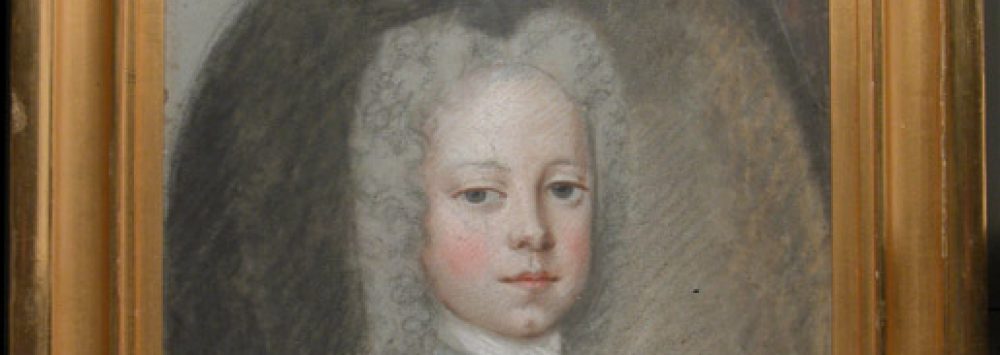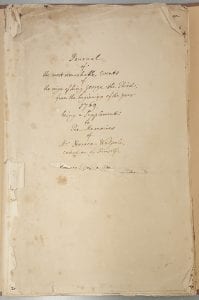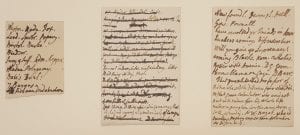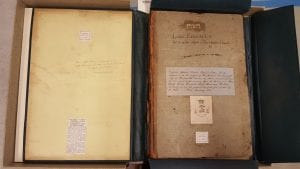Choice 21: Manuscript of Walpole’s Journal for 1769
by Wilmarth S. Lewis
“The manuscript of Walpole’s journal for 1769 came from Upton along with the manuscripts of Walpole’s first and last memoirs, fragments of his printed memoirs, and many notes ‘written flying’ for all of them. The title-page for the manuscript I am saving is, ‘Journal/of the most remarkable Events/of/the reign of King George the third,/from the beginning of the year/1769/being a Supplement/to/The memoirs of/Mr Horace Walpole/carried on by Himself.’ It continues into 1771 with scattered jottings and newspaper cuttings. The whole runs to some 70,000 words, mostly on folio sheets. How Walpole used his journals is seen by the entry for 5 March 1770: ‘The House of Commons went on the affairs of America. Lord North proposed to repeal all the late duties but that on teas. Mr. Conway was for the repeal of that also, as most men were persuaded a partial repeal would produce no content. Grenville so far agreed with the Rockingham part of the Opposition as to condemn a partial repeal, but too stiff to yield on any repeal, he went away without voting.’ This passage became in the Memoirs of George III, ‘On the 5th of March the House of Commons went upon the consideration of America. Lord North proposed to repeal all the late duties, but that on tea. Mr Conway advised the repeal of that also, most men believing that a partial repeal would produce no content. Grenville agreed in condemning as the Rockingham party did too, a partial repeal; but, too obstinate to consent to any repeal, went away without voting, and the motion passed.’
“The manuscript of Walpole’s first memoirs, which I believe he began in 1745, has the title, ‘Memoires. From the Declaration of the War with Spain,’ in 1739. The manuscript runs to about 7000 words with an epigraph that fits all the subsequent memoirs and journals, ‘Nothing extenuate nor set down aught in malice. Othello.’ Gray’s letter of 15 December 1746 shows that he knew Walpole was engaged on this undertaking. ‘Among all the little folks, my godsons and daughters,’ he wrote, ‘I cannot choose but to inquire more particularly after the health of one; I mean (without a figure) the Memoirs. Do they grow? Do they unite, and hold up their heads, and dress themselves? Do they begin to think of making their appearance in the world, that is to say, fifty years hence, to make posterity stare, and all good people cross themselves?’
“‘The War with Spain’ has yet to be published, but when it appears readers will see that Walpole’s intention in his later memoirs was already formed. ‘I write for Posterity, not for my contemporaries,’ he announced in this earliest of his memoirs, ‘and profess speaking my opinion for their information. . . . The intention of this work being to let my Readers rather into the character of the Actors, than into the minute Events of the Drama. The Laborious two hundred years hence may draw out a journal of what month the miscarriage happened before Toulon; or on what day the Battle of Dettingen was fought.’ Horace Walpole, who lived at the center of affairs and who knew all the chief persons in them, was revealing to us not only what happened, but how it happened. Let ‘the laborious,’ the drudges of history, look up the date of Dettingen, he would show us the characters of the men who brought it about.
“He recorded in ‘Short Notes’ that ‘about this time [1751] I began to write my memoirs. At first I intended only to write the history of one year.’ Gray wrote him in October 1751, ‘I rejoice to find you apply (pardon the use of so odious a word) to the history of your own times. Speak, and spare not. Be as impartial as you can; and after all, the world will not believe you are so, though you should make as many protestations as Bishop Burnet,’ who wrote in the Preface to the History of His own Time, ‘I writ with a design . . . to lay open the good and bad of all sides and parties as clearly and impartially as I myself understood it . . . without any regard to kindred or friends, to parties or interests. For I do solemnly say this to the world, and make my humble appeal upon it to the great God of truth, that I tell the truth on all occasions, as fully and freely as upon my best inquiry I have been able to find it out.’
“Far from ending his memoirs in 1751, Walpole carried them on forty years longer. Early in 1752 he recorded, ‘I sit down to resume a task, for which I fear posterity will condemn the author, at the same time that they feel their curiosity gratified. On reviewing the first part of these Memoirs, I find the truth rigidly told.’ They were, he said, his ‘favorite labor,’ yet only Gray, Bentley, Montagu, Mme du Deffand, and probably Conway knew he was writing them. He thought a great deal of their final disposition, ending up with a memorandum to his executors written less than a year before his death. A copy of it in Miss Berry’s hand came to Farmington in the second Waller Sale. Walpole directed, ‘Not to be opened till after my will.’ the memorandum begins,
In my Library at Strawberry Hill are two wainscot chests or boxes, the larger marked with an A, the lesser with a B. I desire, that as soon as I am dead, my Executor and Executrix will cord up strongly and seal the larger box, marked A, and deliver it to the Honourable Hugh Conway Seymour, to be kept by him unopened and unsealed till the eldest son of Lady Waldegrave or whichever of her sons, being Earl of Waldegrave, shall attain the age of twenty-five years; when the said chest, with whatever it contains, shall be delivered to him for his own. And I beg that the Honourable Hugh Conway Seymour, when he shall receive the said chest, will give a promise in writing, signed by him, to Lady Waldegrave, that he or his Representatives will deliver the said chest unopened and sealed, by my Executor and Executrix, to the first son of Lady Waldegrave who shall attain the age of twenty-five years; the key of the said chest is in one of the cupboards in the Green Closet, within the Blue Breakfast Room, at Strawberry Hill, and that key, I desire, may be delivered to Laura, Lady Waldegrave, to be kept by her till her son shall receive the chest.
(Signed) Hor. Walpole, Earl of Orford.
August 19, 1796.
“These directions were carried out by his executors, Mrs Damer and her uncle Lord Frederick Campbell.
“When Chest A was opened by the sixth Earl Waldegrave in 1810 it was found to contain twenty-three folio volumes of memoirs and journals from 1746 to 1791, a total of some three million words.
“Memoirs of the Last Ten Years of the Reign of George the Second was published by John Murray in 1822. I have the drawings Bentley and Müntz made for them, thanks to Mrs Hallam Murray and the good offices of John Hodgson. Walpole describes the frontispiece, ‘The Author leaning on a globe of the world between Heraclitus and Democritus, presents his book to the latter. In the Landscape is a view of the Author’s villa at Strawberry Hill near Twickenham, where the Memoirs were chiefly written.’ Richard Bentley brought out Memoirs of the Reign of King George the Third in 1845 and Journal of the Reign of King George the Third from 1771 to 1783 in 1859. The manuscripts of them from 1784 to 1791 are at Farmington and will appear for the first time in the Yale Edition of Horace Walpole’s Memoirs.
“The memoirs have suffered from their editors who cut out passages they thought indelicate, offensive to living persons, or just plain dull, and although they said they had indicated these omissions they often failed to do so. Doran, the editor of Walpole’s Last Journals, printed newspaper cuttings Walpole pasted on the manuscript as if they were written by Walpole himself….”
Lewis then elaborates on the the deficiencies of the Doran edition and the merits of the then forthcoming Yale Edition.
“When The Memoirs of the Reign of George the Second came out in 1822 Walpole was criticized for the severity of his judgments on his contemporaries. They seem savage to us also, but we must remember that he was following the tradition of his time, when, as he wrote, ‘Similes and quotations, metaphors’ in the House of Commons ‘were fallen into disrepute,’ but ‘it was not the same with invectives. . . . Debates, where no personalities broke out, engaged too little attention.’ There was also what Virginia Woolf calls, ‘the presence of obsolete conventions inherited from an earlier and still more ferocious time.’ One of these conventions was unbridled personal abuse and the memoirs are less remarkable for their savagery than for Walpole’s uneasiness about the effect of his savagery on us. That concern is something new.”
Lewis explores the intended audience for the Memoirs, possible reactions to the text, and provides examples of some of the more interesting passages on individuals.
“…If you are annoyed and an historian you may re-examine other passages in the spirit that filled Walpole himself when he set out to prove established historians prejudiced and untrustworthy. in his Memoirs he threw off the restraint that guarded his letters. When writing Lady Ossory or Cole he wanted to keep their respect. They and others were saving his letters and one day they would be printed. That was a sobering thought. He did frequently let himself go in his letters, particularly when writing to Mason who brought out his worst side, but he usually ended by apologizing or laughing at himself and so toned down his asperities.
“Although he was under no such restraint in the Memoirs, he feared for their reception. He did not worry about his statements of fact because he knew ‘the laborious’ would verify them; the Duke of Grafton when Prime Minister said that there was no one from whom he ‘received so just accounts of the schemes of the various factions’ as from Walpole or ‘had so good means of getting the knowledge of what was passing.’ What Walpole worried about were his ‘characters.’ They had honorable precedents in Clarendon and Bishop Burnet who had also written in passion. Some of Walpole’s readers would enjoy his severity, but ‘I am aware,’ he wrote, ‘that more will be offended at the liberty I have taken in painting men as they are: and that many, from private connections of party and family, will dislike meeting such unflattered portraits of their heroes or their relations.’ He warded off criticism on this score. ‘Few men,’ he pointed out, ‘can sit for patterns of perfect virtue.’ He had taken posterity into the secret councils of the time and exposed its principal actors, yet he feared his strictures might hurt him as much as the people he was exposing and he longed for our approval of his work and himself. He was like a man who has written many letters in anger that he prudently did not send, but who on re-reading them later is torn between shame of his intemperance and admiration of his force. The Memoirs gave him a sense of power. In the library at Strawberry working secretly at night, he was settling the reputations of his more powerful political contemporaries. He could not make history, but he could write it, and posterity would learn from him how the events of his time came about.”
Lewis, Wilmarth S. Rescuing Horace Walpole. New Haven and London: Yale University Press, 1978.
To see the full chapter from Rescuing Horace Walpole called “Choice 21: Manuscript of Walpole’s Journal for 1769” download or expand the link here:
 Loading...
Loading...
N.B. The three manuscript notes shown in the image are to be found as “Political notes,” call number LWL MSS 1 Series II, Box 41, Folders 35, 36, and 28 respectively.






